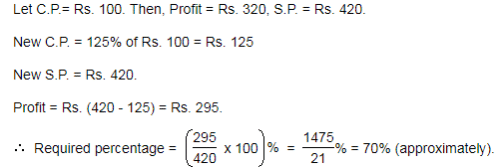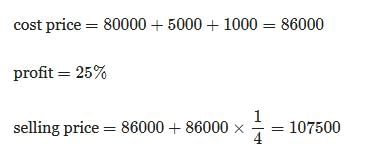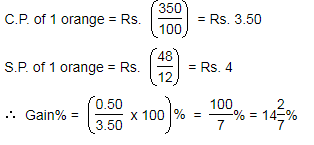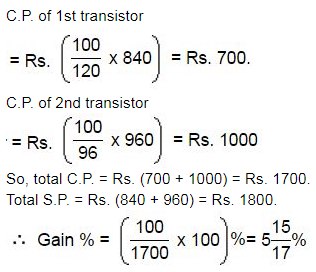All Exams >
Mechanical Engineering >
General Aptitude for GATE >
All Questions
All questions of Profit & Loss for Mechanical Engineering Exam
A sells a car to B at 10% loss. If B sells it for Rs. 54000 and gains 20%, the cost price of the car for A was
a)Rs. 25000
b)Rs. 50000
c)Rs. 37500
d)Rs. 60000
Correct answer is option 'B'. Can you explain this answer?
|
|
Gaurav Datta answered |
Selling price of the car = Rs.54,000
gain 20%
Friend's cost price of the car = Rs. 54000 x 100/120 = Rs.45,000
Now selling price of the car of the first owner Rs.45000
Loss 10%
Cost price of the car = 45000 x 100/90
= Rs.50,000
gain 20%
Friend's cost price of the car = Rs. 54000 x 100/120 = Rs.45,000
Now selling price of the car of the first owner Rs.45000
Loss 10%
Cost price of the car = 45000 x 100/90
= Rs.50,000
If a material is sold for Rs.34.80, there is a loss of 25%. Find out the cost price of the material?
- a)Rs.46.40
- b)Rs.44
- c)Rs.42
- d)Rs.47.20
Correct answer is option 'A'. Can you explain this answer?
If a material is sold for Rs.34.80, there is a loss of 25%. Find out the cost price of the material?
a)
Rs.46.40
b)
Rs.44
c)
Rs.42
d)
Rs.47.20
|
|
Kavya Saxena answered |
The correct answer is A as
cost price = SPX100/100-loss
=34.80×100/75
=46.40
cost price = SPX100/100-loss
=34.80×100/75
=46.40
A dishonest dealer marks up the price of his goods by 20% and gives a discount of 10% to the customer. Besides, he also cheats both his supplier and his buyer by 100 grams while buying or selling 1 kilogram. Find the percentage profit earned by the shopkeeper.
- a)20%
- b)25%
- c)27.5%
- d)32%
Correct answer is option 'D'. Can you explain this answer?
A dishonest dealer marks up the price of his goods by 20% and gives a discount of 10% to the customer. Besides, he also cheats both his supplier and his buyer by 100 grams while buying or selling 1 kilogram. Find the percentage profit earned by the shopkeeper.
a)
20%
b)
25%
c)
27.5%
d)
32%

|
Arya Roy answered |

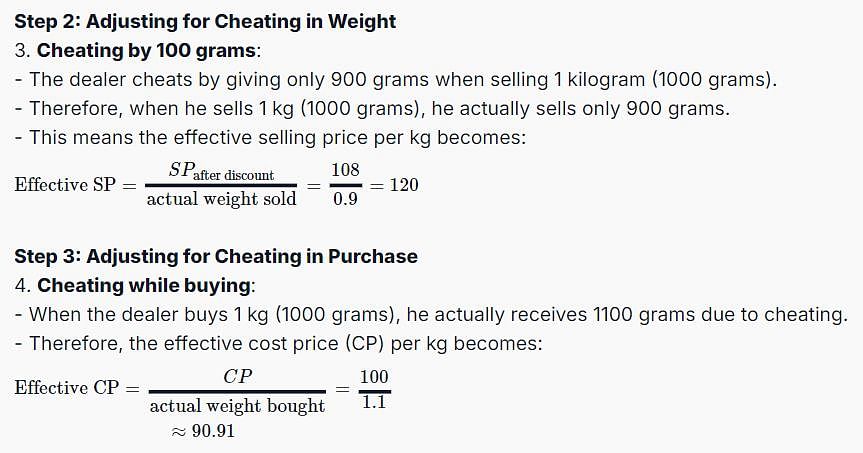

John buys an old scooter for Rs. 4700 and spends Rs. 800 on its repairs. If he sells the scooter for Rs. 5800, what is his gain percent ?
- a)12%
- b)10%
- c)4 + 4 / 7%
- d)5 + 5 / 11%
Correct answer is option 'D'. Can you explain this answer?
John buys an old scooter for Rs. 4700 and spends Rs. 800 on its repairs. If he sells the scooter for Rs. 5800, what is his gain percent ?
a)
12%
b)
10%
c)
4 + 4 / 7%
d)
5 + 5 / 11%
|
|
Milan Chaudhary answered |
Whenever we get this type of question, we should have formula in mind that,
Gain% = (gain/cost) x 100
Cost = 4700 + 800 = Rs. 5500
S.P. = Rs. 5800
Profit = 5800 - 5500 = 300
Gain% = (gain/cost) x 100
Cost = 4700 + 800 = Rs. 5500
S.P. = Rs. 5800
Profit = 5800 - 5500 = 300

A fruit seller sells apples at the rate of Rs.9 per kg and thereby loses 20%. At what price per kg, he should have sold them to make a profit of 5%?
- a)11.32
- b)11
- c)12
- d)11.81
Correct answer is option 'D'. Can you explain this answer?
A fruit seller sells apples at the rate of Rs.9 per kg and thereby loses 20%. At what price per kg, he should have sold them to make a profit of 5%?
a)
11.32
b)
11
c)
12
d)
11.81

|
Pooja Pawar answered |
Loss is 20% then 9rp is = 80% cost
use unitary method
80 = 9rp
then
1000= 11.25
then 105 = 11.81
use unitary method
80 = 9rp
then
1000= 11.25
then 105 = 11.81
A man sells a TV set for Rs. 33000 and makes a profit of 10%. He sells another TV at a loss of 20%. If on the whole, he neither gains nor loses, find the selling price of the second TV set.
- a)Rs.15,000
- b)Rs.30,000
- c)Rs.12,000
- d)Rs.27,000
Correct answer is option 'C'. Can you explain this answer?
A man sells a TV set for Rs. 33000 and makes a profit of 10%. He sells another TV at a loss of 20%. If on the whole, he neither gains nor loses, find the selling price of the second TV set.
a)
Rs.15,000
b)
Rs.30,000
c)
Rs.12,000
d)
Rs.27,000
|
|
Aarav Sharma answered |
Given:
Selling price of first TV set = Rs. 33000
Profit earned on first TV set = 10%
To find: Selling price of the second TV set
Let's assume the cost price of the first TV set = x
Profit earned on the first TV set = 10%
Therefore, selling price of the first TV set = x + 0.1x = 1.1x
Selling price of the first TV set = Rs. 33000
So, 1.1x = 33000
x = 30000
Cost price of the second TV set = y
Loss incurred on the second TV set = 20%
Therefore, selling price of the second TV set = y - 0.2y = 0.8y
Now, let's assume that the man sells the second TV set at a selling price of z.
Total selling price of both the TV sets = 33000 + z
Total cost price of both the TV sets = 30000 + y
It is given that the man neither gains nor loses on the whole, i.e., total selling price = total cost price
33000 + z = 30000 + y + 0.8y
33000 + z = 38000 + 0.8y
z = 38000 - 0.8y
Substituting the value of z in the above equation, we get:
33000 + 38000 - 0.8y = 30000 + y
71000 - 0.8y = 30000 + y
71000 = 1.8y
y = 71000/1.8
y = 39444.44
Selling price of the second TV set = 0.8y = 0.8 x 39444.44 = Rs. 31555.56
Therefore, option (c) Rs. 27,000 is incorrect and the correct answer is option (a) Rs. 15,000.
Selling price of first TV set = Rs. 33000
Profit earned on first TV set = 10%
To find: Selling price of the second TV set
Let's assume the cost price of the first TV set = x
Profit earned on the first TV set = 10%
Therefore, selling price of the first TV set = x + 0.1x = 1.1x
Selling price of the first TV set = Rs. 33000
So, 1.1x = 33000
x = 30000
Cost price of the second TV set = y
Loss incurred on the second TV set = 20%
Therefore, selling price of the second TV set = y - 0.2y = 0.8y
Now, let's assume that the man sells the second TV set at a selling price of z.
Total selling price of both the TV sets = 33000 + z
Total cost price of both the TV sets = 30000 + y
It is given that the man neither gains nor loses on the whole, i.e., total selling price = total cost price
33000 + z = 30000 + y + 0.8y
33000 + z = 38000 + 0.8y
z = 38000 - 0.8y
Substituting the value of z in the above equation, we get:
33000 + 38000 - 0.8y = 30000 + y
71000 - 0.8y = 30000 + y
71000 = 1.8y
y = 71000/1.8
y = 39444.44
Selling price of the second TV set = 0.8y = 0.8 x 39444.44 = Rs. 31555.56
Therefore, option (c) Rs. 27,000 is incorrect and the correct answer is option (a) Rs. 15,000.
Murali purchased 20 dozens of toys at the rate of Rs. 375 per dozen. He sold each one of them at the rate of Rs. 33. Find out his profit percentage.- a)3.5
- b)5.6
- c)4.1
- d)3.4
Correct answer is 'B'. Can you explain this answer?
Murali purchased 20 dozens of toys at the rate of Rs. 375 per dozen. He sold each one of them at the rate of Rs. 33. Find out his profit percentage.
a)
3.5
b)
5.6
c)
4.1
d)
3.4

|
Gowri Chakraborty answered |
The cost price of 20 dozens of toys = 375*20 i.e per dozen 375= Rs 7500/-the selling price of one dozen toys = 12*33= Rs 396/-the selling price of 20 dozen toys = 396*20= Rs 7920/-gain=sp-cp = 7920-7500 =Rs.420/-gain%=(gain/cp)*100 = 420/7500*100 =5.6%
On selling 17 balls at Rs. 720, there is a loss equal to the cost price of 5 balls. What is the cost price of a ball?
- a)Rs. 43
- b)Rs. 60
- c)Rs. 55
- d)Rs. 34
Correct answer is option 'B'. Can you explain this answer?
a)
Rs. 43
b)
Rs. 60
c)
Rs. 55
d)
Rs. 34
|
|
Alok Verma answered |
Let the cost price of a ball be Rs. x.
So, the CP of 17 balls is Rs. 17x.
The CP of 5 balls is Rs. 5x.
Since Loss = CP - SP
So, 5x = 17x - 720
On solving, we get
12 x = 720
that is, x = 60
So, the cost price of a ball is Rs. 60.
A vendor bought bananas at 6 for a rupee. How many for a rupee must he sell to gain 20%?
- a)3
- b)4
- c)5
- d)6
Correct answer is 'C'. Can you explain this answer?
a)
3
b)
4
c)
5
d)
6

|
Pallabi Deshpande answered |
Go through this doc which will help you understand the basic concepts of profit, loss, and discount for CAT exam.
E sold at table to R at a profit of 25%.R sold the same table to S for Rs. 90 thereby making a profit of 20%. Find the price at which E bought the table from Z if it is known that Z gained 25% in the transaction.
- a)Rs.80
- b)Rs.75
- c)Rs.90
- d)Rs.60
Correct answer is option 'D'. Can you explain this answer?
E sold at table to R at a profit of 25%.R sold the same table to S for Rs. 90 thereby making a profit of 20%. Find the price at which E bought the table from Z if it is known that Z gained 25% in the transaction.
a)
Rs.80
b)
Rs.75
c)
Rs.90
d)
Rs.60
|
|
Ritika Choudhury answered |
R sold the table at 20% profit at Rs. 90. Thus cost price would be given by: CPR X 1.2 = 90
R’s Cost price = Rs. 75.
We also know that E sold it to R at 25% profit. Thus,
E’s Cost price X 1.25 = 75
-> E’s cost price = 60.
R’s Cost price = Rs. 75.
We also know that E sold it to R at 25% profit. Thus,
E’s Cost price X 1.25 = 75
-> E’s cost price = 60.
A man sells an article at 10% above its cost price. If he had bought it at 15% less than what he paid for it and sold it for Rs. 33 less, he would have gained 10%. Find the cost price of the article.- a)Rs.400
- b)Rs.200
- c)Rs.325
- d)Rs.260
Correct answer is option 'B'. Can you explain this answer?
A man sells an article at 10% above its cost price. If he had bought it at 15% less than what he paid for it and sold it for Rs. 33 less, he would have gained 10%. Find the cost price of the article.
a)
Rs.400
b)
Rs.200
c)
Rs.325
d)
Rs.260

|
Surbhi Joshi answered |
Given:
Selling price = Cost price + 10% of cost price
Let the cost price be x
Selling price = 1.1x
To find:
Cost price of the article
Solution:
Let the original selling price be y
The cost price of the article if he had bought it at 15% less than what he paid for it = 0.85y
He sold it for Rs. 33 less, so the selling price = y - 33
He gained 10%
Selling price = Cost price + 10% of cost price
1.1x = 1.1(0.85y) + 0.1(0.85y)
1.1x = 0.935y + 0.085y
1.1x = 1.02y
y = 1.078x
Substituting the value of y in the equation y - 33 = 1.1(0.85y)
1.078x - 33 = 0.935y
1.078x - 33 = 0.935(1.078x)
1.078x - 33 = 1.00883x
0.06917x = 33
x = 33/0.06917
x = Rs. 476.86
Therefore, the cost price of the article is Rs. 476.86
But, the options given are not in decimals
So, the closest option to Rs. 476.86 is Rs. 200
Hence, the correct option is (B) Rs. 200.
Selling price = Cost price + 10% of cost price
Let the cost price be x
Selling price = 1.1x
To find:
Cost price of the article
Solution:
Let the original selling price be y
The cost price of the article if he had bought it at 15% less than what he paid for it = 0.85y
He sold it for Rs. 33 less, so the selling price = y - 33
He gained 10%
Selling price = Cost price + 10% of cost price
1.1x = 1.1(0.85y) + 0.1(0.85y)
1.1x = 0.935y + 0.085y
1.1x = 1.02y
y = 1.078x
Substituting the value of y in the equation y - 33 = 1.1(0.85y)
1.078x - 33 = 0.935y
1.078x - 33 = 0.935(1.078x)
1.078x - 33 = 1.00883x
0.06917x = 33
x = 33/0.06917
x = Rs. 476.86
Therefore, the cost price of the article is Rs. 476.86
But, the options given are not in decimals
So, the closest option to Rs. 476.86 is Rs. 200
Hence, the correct option is (B) Rs. 200.
The cost price of 20 articles is the same as the selling price of x articles. If the profit is 25%, find out the value of x
- a)15
- b)25
- c)18
- d)16
Correct answer is 'D'. Can you explain this answer?
a)
15
b)
25
c)
18
d)
16

|
Sameer Rane answered |
Let C.P. of each article be Re. 1 C.P. of x articles = Rs. x.S.P. of x articles = Rs. 20.Profit = Rs. (20 - x).because [(20 - x)/x] x 100 = 25=> 2000 - 100x = 25x=> 125x = 2000 x = 16.
A trader gives 12% additional discount on the discounted price, after giving an initial discount of 20% on the labeled price of an item. The final sale price of the item is Rs.704. Find out the labeled price?
- a)1000
- b)2000
- c)1200
- d)920
Correct answer is option 'A'. Can you explain this answer?
a)
1000
b)
2000
c)
1200
d)
920

|
Gowri Chakraborty answered |

Murali purchased 20 dozens of toys at the rate of Rs. 375 per dozen. He sold each one of them at the rate of Rs. 33. Find out his profit percentage.- a)3.5
- b)5.6
- c)4.1
- d)3.4
Correct answer is option 'B'. Can you explain this answer?
Murali purchased 20 dozens of toys at the rate of Rs. 375 per dozen. He sold each one of them at the rate of Rs. 33. Find out his profit percentage.
a)
3.5
b)
5.6
c)
4.1
d)
3.4

|
Arya Roy answered |
Cost Price of 1 toy = Rs.375/12 = Rs. 31.25
Selling Price of 1 toy = Rs. 33
So, Gain = Rs. (33 - 31.25) = Rs. 1.75
Profit % = [(1.75/31.25) x 100 ]% = 28/5 % = 5.6%
A trader mixes 26 kg of rice at Rs. 20 per kg with 30 kg of rice of other variety at Rs. 36 per kg and sells the mixture at Rs. 30 per kg. What is his profit percentage?
- a)6%
- b)5%
- c)4%
- d)7%
Correct answer is option 'B'. Can you explain this answer?
A trader mixes 26 kg of rice at Rs. 20 per kg with 30 kg of rice of other variety at Rs. 36 per kg and sells the mixture at Rs. 30 per kg. What is his profit percentage?
a)
6%
b)
5%
c)
4%
d)
7%

|
Manoj Ghosh answered |
C.P. of 56 kg rice = Rs. (26 x 20 + 30 x 36) = Rs. (520 + 1080) = Rs. 1600.
S.P. of 56 kg rice = Rs. (56 x 30) = Rs. 1680.
Gain =(80/1600*100) % = 5%
When an item is sold for Rs. 18,700, the owner loses 15%. At what price should that plot be sold to get a gain of 15%?
- a)Rs. 25100
- b)Rs. 24200
- c)Rs. 25300
- d)Rs. 21200
Correct answer is option 'C'. Can you explain this answer?
a)
Rs. 25100
b)
Rs. 24200
c)
Rs. 25300
d)
Rs. 21200

|
Avi Shah answered |
First we find CP.
If SP is Rs. 85 then CP = Rs 100
If SP is Rs. 18,700, then
CP = = Rs 22,000
= Rs 22,000
Now, if CP is Rs 100, then SP = Rs. 115
Thus, if CP is Rs. 22,000, then
SP = =Rs 25,300
=Rs 25,300
If SP is Rs. 85 then CP = Rs 100
If SP is Rs. 18,700, then
CP =
 = Rs 22,000
= Rs 22,000Now, if CP is Rs 100, then SP = Rs. 115
Thus, if CP is Rs. 22,000, then
SP =
 =Rs 25,300
=Rs 25,300The cost price of 20 articles is the same as the selling price of x articles. If the profit is 25%, find out the value of x
- a)15
- b)25
- c)18
- d)16
Correct answer is option 'D'. Can you explain this answer?
a)
15
b)
25
c)
18
d)
16

|
Dhruv Mehra answered |
Let the Cost Price of one article = Rs. 1
CP of x articles = Rs. x
CP of 20 articles = 20
Selling price of x articles = 20
Profit = 25% [Given]
⇒ (SP - CP) / CP = 25 / 100 = 1/4 ⇒ (20-x) / x = 1/4
⇒ 80−4x=x
⇒ 5x=80
⇒ x = 80/5 = 16
Chapter doubts & questions for Profit & Loss - General Aptitude for GATE 2025 is part of Mechanical Engineering exam preparation. The chapters have been prepared according to the Mechanical Engineering exam syllabus. The Chapter doubts & questions, notes, tests & MCQs are made for Mechanical Engineering 2025 Exam. Find important definitions, questions, notes, meanings, examples, exercises, MCQs and online tests here.
Chapter doubts & questions of Profit & Loss - General Aptitude for GATE in English & Hindi are available as part of Mechanical Engineering exam.
Download more important topics, notes, lectures and mock test series for Mechanical Engineering Exam by signing up for free.
General Aptitude for GATE
194 videos|167 docs|152 tests
|
Signup to see your scores go up within 7 days!
Study with 1000+ FREE Docs, Videos & Tests
10M+ students study on EduRev

Contact Support
Our team is online on weekdays between 10 AM - 7 PM
Typical reply within 3 hours
|
Free Exam Preparation
at your Fingertips!
Access Free Study Material - Test Series, Structured Courses, Free Videos & Study Notes and Prepare for Your Exam With Ease

 Join the 10M+ students on EduRev
Join the 10M+ students on EduRev
|

|
Forgot Password
OR
Signup to see your scores
go up within 7 days!
Access 1000+ FREE Docs, Videos and Tests
Takes less than 10 seconds to signup

